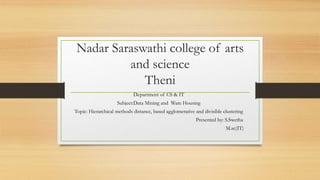
Data mining and warehousing
- 1. Nadar Saraswathi college of arts and science Theni Department of CS & IT Subject:Data Mining and Ware Housing Topic: Hierarchical methods distance, based agglomerative and divisible clustering Presented by: S.Swetha M.sc(IT)
- 2. Introduction • Distance or proximity measures are used to determine the similarity or “closeness” between similar objects in the dataset. The goal of proximity measures is to find similar objects and to group them in the same cluster. • The goal of proximity measures is to find similar objects and to group them in the same cluster. • Some common examples of distance measures that can be used to compute the proximity matrix in hierarchical clustering, including the following:
- 3. Continue….. • Euclidean Distance • Mahalanobis Distance • Minkowski Distance • I would avoid the mathematical formulas involved in explaining the distances but rather summarise the uses and functions of these distance measures. A simple google search can provide tons of examples and research papers if you are interested in learning the underlying principles which support these calculations.
- 4. Agglomerative hierarchical clustering: • Agglomerative clustering is one of the most common types of hierarchical clustering used to group similar objects in clusters. Agglomerative clustering is also known as AGNES (Agglomerative Nesting). In agglomerative clustering, each data point act as an individual cluster and at each step, data objects are grouped in a bottom-up method. Initially, each data object is in its cluster. At each iteration, the clusters are combined with different clusters until one cluster is formed.
- 5. • With the help of given demonstration, we can understand that how the actual algorithm work. Here no calculation has been done below all the proximity among the clusters are assumed. • Let’s suppose we have six different data points P, Q, R, S, T, V.
- 7. Diagram:
- 8. Steps • Consider each alphabet (P, Q, R, S, T, V) as an individual cluster and find the distance between the individual cluster from all other clusters. • Now, merge the comparable clusters in a single cluster. Let’s say cluster Q and Cluster R are similar to each other so that we can merge them in the second step. Finally, we get the clusters [ (P), (QR), (ST), (V)]. • Here, we recalculate the proximity as per the algorithm and combine the two closest clusters [(ST), (V)] together to form new clusters as [(P), (QR), (STV)].
- 9. Continue….. • Repeat the same process. The clusters STV and PQ are comparable and combined together to form a new cluster. Now we have [(P), (QQRSTV)]. • Finally, the remaining two clusters are merged together to form a single cluster [(PQRSTV)].
- 10. Divisive Hierarchical Clustering: • Divisive hierarchical clustering is exactly the opposite of Agglomerative Hierarchical clustering. In Divisive Hierarchical clustering, all the data points are considered an individual cluster, and in every iteration, the data points that are not similar are separated from the cluster. The separated data points are treated as an individual cluster. Finally, we are left with N clusters.
- 12. Advantages of Hierarchical clustering: • It is simple to implement and gives the best output in some cases. • It is easy and results in a hierarchy, a structure that contains more information. • It does not need us to pre-specify the number of clusters.
- 13. Disadvantages of hierarchical clustering: • It breaks the large clusters. • It is Difficult to handle different sized clusters and convex shapes. • It is sensitive to noise and outliers. • The algorithm can never be changed or deleted once it was done previously.